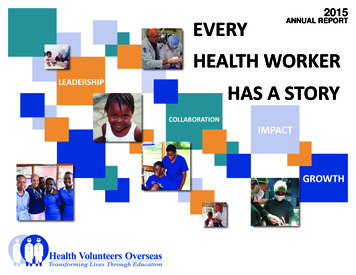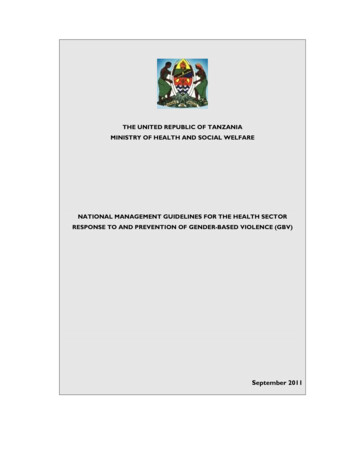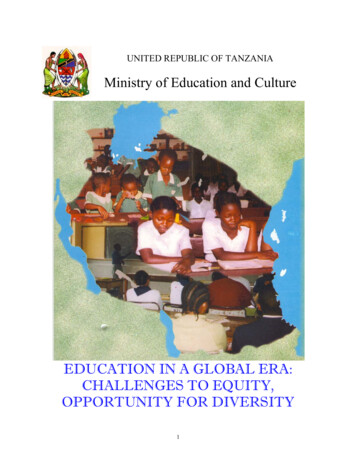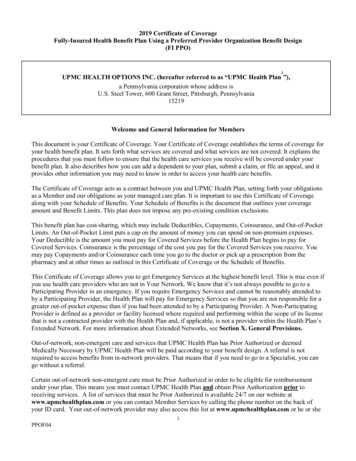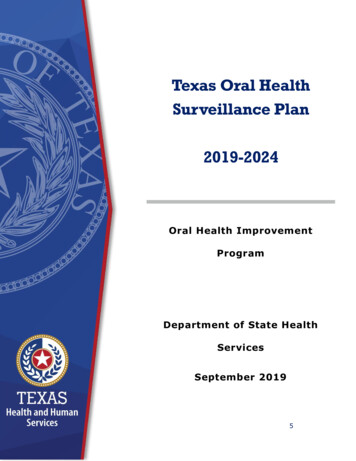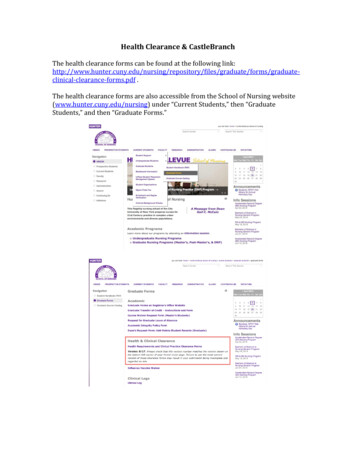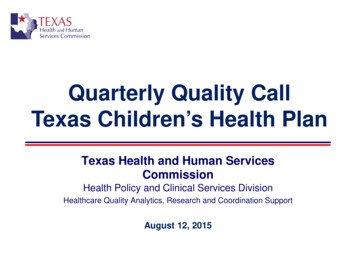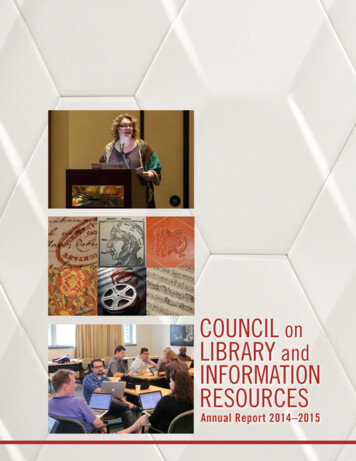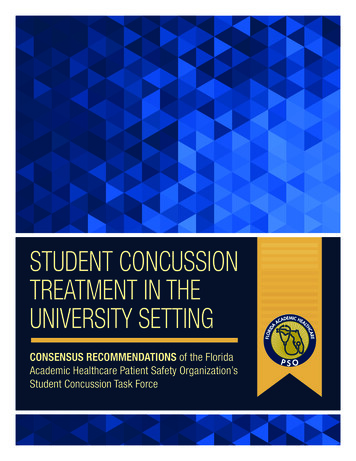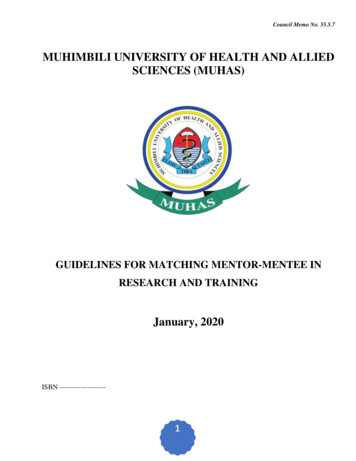
Transcription
Council Memo No. 55.5.7MUHIMBILI UNIVERSITY OF HEALTH AND ALLIEDSCIENCES (MUHAS)GUIDELINES FOR MATCHING MENTOR-MENTEE INRESEARCH AND TRAININGJanuary, 2020ISBN --------------------1
Council Memo No. 55.5.7Muhimbili University of Health and Allied SciencesPo Box 65001Dar es Salaam, TanzaniaTel: 255 22 21510465Email:vc@muhas.ac.tz Copyright of MUHAS2
Council Memo No. 55.5.7PREFACEOn behalf of Muhimbili University of Health and Allied Sciences (MUHAS), I have the pleasure tointroduce the MUHAS second version of Mentoring Guidelines. These guidelines focus on matchingmentor-mentee in research and training activities. The guidelines have been adapted from the formerversion of 2005 when Muhimbili University College of Health Sciences (MUCHS) was intransformation into a fully-fledged University. Following upgrading of MUCHS to a fully-fledgedUniversity, MUHAS has expanded training programs, research and consultancy acticities. Therefore,guidelines for essential relationships between academic members of staff, students and prospectiveemployees is enevitably needed. After becoming a fully-fledged University in 2007, MUHAS hasdeveloped a number of policies and guidelines to guide how different relationships and interactionswould be handled in the learning and working environment. Among such policies and guidelinesinclude: (a) The Policy Against Sexual Harrassment and Discrimination, 2007; (b) MUHAS ResearchAgenda, 2011; (c) Gender Policy, 2013; (d) Human Resources Training and Development Policy, 2012;and (e) General Regulations and Guidelines for Postgraduate Programs, 2016.Career and proffesionalguidance in research and training need to be emphasized beyond supervision of academic works.Therefore, guidelines for matching mentor-mentee in research and training would create more conduciveenvironment in guiding early career staff, students, and senior staff members to (a) Enhance personalsatisfaction from making a difference in the career development of another persons; (b) Enhancediffusion of soft skills needed in one‘s profession such as leadership, interpersonal and team forming,communication, and critical thinking; (c) Increase efficiency in research and training activities at theUniversity through guidance offered by different university units; (d) Enhance profile of the Universityand its visibility in the Public services; and (e) Develop networks among MUHAS clients and its internaland external stakeholders.I wish to convey my sincere gratitude to the committee which worked tirelessly for development ofthis document under the support of the Association of Commonwealth Universities & Climate ImpactsResearch Capacity and Leadership Enhancement in Sub-Saharan Africa (ACU-CIRCLE) program. I amalso grateful to the representation of faculty and students who made contributions to this document. It ismy hope that the University community and stakeholders will find this document useful and willendeavor to make full use of it to enhance teaching and research at MUHAS.Vice Chancellor, Dar es Salaam, January, 20203
Council Memo No. 55.5.7TABLE OF CONTENTS12CHAPTER ONE: BACKGROUND AND PURPOSE . 51.1INTRODUCTION . 51.2PURPOSE AND CONTEXT . 61.3DEFINITION AND TERMS . 7CHAPTER TWO: ROLE AND RESPONSIBILITIES OF MENTOR, MENTEE AND MENTORINGINSTITUTION. . 92.12.1.1ROLES OF THE MENTOR . 92.1.2ROLE OF THE MENTEE . 102.1.3ROLES OF THE INSTITUTIONS . 102.23RESPONSIBILITIES . 112.2.1THE MENTOR RESPONSIBILITY . 112.2.2THE MENTEE RESPONSIBILITY . 122.2.3THE INSTITUTION RESPONSIBILITY . 13CHAPTER THREE: PROCEDURE FOR MATCHING MENTOR-MENTEES . 153.1CRITERIA FOR SELECTION AND ACCEPTANCE OF A MENTOR . 153.2GENERAL PROCEDURES FOR MATCHING MENTOR-MENTEE . 153.3MENTOR-MENTEE MATCHING FOR STUDENTS. 163.3.1UNDERGRADUATE STUDENTS. 163.3.2POSTGRADUATE STUDENTS . 173.44ROLES . 9MENTOR-MENTEE MATCHING FOR STAFF . 173.4.1MATCHING FOR EARLY CAREER RESEARCHERS . 183.4.2MATCHING FOR SENIOR RESEARCHERS/STAFF . 18APPENDICES. 19Form for Request for Allocation of a Formal Mentor . 19Progress Report for Academic Mentorship . 21Progress Report for Research Mentorship . 23Form for Non-MUHAS Volunteer for Academic Mentors . 25Form for Non-MUHAS Volunteer for Research Mentors . 26Guide for Mentorship Meeting . Error! Bookmark not defined.4
Council Memo No. 55.5.711.1CHAPTER ONE: BACKGROUND AND PURPOSEINTRODUCTIONEffective learning takes place in an environment conducive for both academic and psychosociallearning. The environment should provide opportunities that encourage interactions between learnersand teachers, students and students, teachers and teachers, and students and other stakeholders. In brief,there should be a positive interaction between the learner and the environment. Consequently, thetransition from high school to University can be a bitter, isolating and hostile experience to somestudents joining University as they strive to cope academically and socially during their studies. Itdemands a need to break with old routines and lifestyle and to adjust to the new demands of Universitylife, which presents fresh intellectual and social challenges.MUHAS has had academic advisors for many years as one way of assisting undergraduatestudents during their study tenure at the University. Normally, each student is assigned to a teacher bythe Dean of the School or Director of Academic Institute. The system randomly allocates a number ofstudents to each of the teachers, usually those who teach the student in one of the courses. In spite of thelong duration of existence of this system, the intended benefits have not been forthcoming. Thedeficiencies of the system, evident to students and graduates, include: Unacceptably large social distance between the academic members of staff and students. Emphasis on academic matters, largely ignoring the social well being or affairs of students. The students developing a negative attitude towards their teachers. A proportion of students leaving the University on graduation with unprofessional attitudes.The current system of assigning Academic Advisors is therefore inadequate, and calls for animprovement; a system that will address the students’ needs and expectation in a more holistic manner.This is the reason behind this initiative to introduce these guidelines for mentor-mentee in research andtraining at MUHAS.In the MUHAS context, however, mentoring of students by teachers is not likely to be a one-to-oneaffair because of the ongoing expansion of the University and its academic programs. For example,when MUHAS became a fully flaged University in 2007, about 1341 students were enrolled intoundergraduate programs and 144 students were enrolled into the various postgraduate programs. Duringthe same period the number of academic staff with PhD and Masters were 74 and 159, respectively.5
Council Memo No. 55.5.7About ten years later in 2016/2017, the University had a total of 2093 students enrolled intoundergraduate programs and 745 students enrolled into postgraduate programs. The total number ofacademic staff for the year 2016/2017 was 298. While the number of undergraduate and staff doubled,that of postgraduate students incresed five times, with 66 postgraduate programs running in 2019. Theaim of this expansion was to produce the required specialists in the different disciplines of healthsciences in the country as well as producing highly qualified academic members of staff. Despite ofthese expansions, currently there are only 28 associate professors and full professors at MUHAS, ofwhich 9 are females. The scenario is therefore that of a senior academic staff undertaking mentoring fora number of students and junior academic staff joining the University and also among senior staff aspeers and with gender diversity.1.2PURPOSE AND CONTEXTMentoring is a powerful personal development tool and offers extensive benefits to all those involved,the mentor, mentee and the organisation. Mentoring is instrumental for professional development as itgives a way and means through career development and progression using scientifically generatedknowledge and academic activities that benefit an individual, the family, community, national and otherstakeholders. Mentoring is a continuous process due to fast changing trend in the world of the skillsneeded for the labour market. The skills that were needed in 20th century during industrial revolutionmay no longer be relevant in 21st century where the world is driven by knowledge based ecomomy suchas use of ICT, automation and intelligence machines. Changing market trend from liberalization toprotectionalism requires professional competencies that survive in the competitive labour market.Furthermore, early career academicians often report that they lack the necessary support to enable themmake right decisions for their lives at the right time as research is increasingly becaming moremultidisciplinary, trans-disciplinary, collaborative and data-intensive. These needs are dependant on theinstitutional strategies for creating mentorship programs that enhances learning environment andcapacity to transfer knowledge into value.The guidelines for matching mentor-mentee in research and training are intended to guide early careerstaff and students to advance their career development and professional skills at the University and aftergraduation. Also for Senior staff at the university and working places to incalcate facilitation andguidance role in career development of youth.6
Council Memo No. 55.5.71.3DEFINITION AND TERMSCareer development: is the lifelong process of managing learning, work, leisure, and transitions inorder to move toward a personally determined and evolving preferred future.Coaching: is a process where experts help others to take responsibility and act to maximize their ownpotential or improve some aspect of performance, normally through problem solving.Counseling: is a process of listening to someone and giving that person advice about his/her problem.Diversity: is about recognizing, respecting and placing positive value on people’s differences tocontribute and realize their full potential by promoting an inclusive culture in learningenvironment.Early career researcher: A Scientist who is on transition to fully independent position as investigator,faculty member, clinician, scientists, or scientific team leader in industry.Equality of opportunity: is about ensuring everybody has an equal chance to take up opportunities andmake full use of the opportunities on offer to fulfil their potential in career and professionaldevelopment.Industry linkage: An establish link betwween the University and employers or professional bodieswithin the sector the mentee are interested in. The mentorship scheme aim to enhance theiremployability, expand their professional network, increase their confidence and help them todevelop key skills that will provide them with a competitive edge in the graduate labourmarket.Learning environment: Refers to the whole range of components and activities within which learninghappens.Mentee: Someone who is given support and advice about his/her job/career/studies by a moreexperienced person (Mentor).Mentor: An experienced and trusted adviser who is not the mentee’s direct line manager or supervisorwho has no direct responsibility to the mentee’s work performance but responsible forencouraging the mentee to work towards their own individual objectives and be a motivatingguide to the mentee on their career journey.7
Council Memo No. 55.5.7Mentoring: A support and encouragement given to people to manage their own learning and careerdevelopment in order that they may maximise their potentials, develop their skills, improvetheir performance and become the person they want to be in life.Mentorship: A mentoring relationship that may vary along a continuum from informal / shortterm toformal/ long term in which faculty with useful experience, knowledge, skills and/or wisdomoffers advice, information, guidance, support, or opportunity to another faculty member orstudent to advance their career and professional development.Mid-career researcher: A scientist who has just acquired a status of being an independent researcher.Peer mentoring: A group of individuals with similar backgrounds who meet regularly to mentor eachother. It employs motivational innovative career approaches programs such as exhibitions,show case ideas etc.Professional development: A training that is given to people working in professions to increase theirknowledge and skills to be able to change their professional thinking, understanding andperception so as to increase effectiveness and efficiency. The organization continuously givethese trainings to its employee in-house or allow them to gain attending training to otherinstitutions.Senior researchers/staff: A highly experienced researcher who conducts training, research, andresearch project related activities, either independently or as part of research teams in aconsortia or network/collaboration.Supervision: A process of monitoring and regulating the performance of assigned or delegated tasks8
Council Memo No. 55.5.72CHAPTER TWO: ROLE AND RESPONSIBILITIES OF MENTOR, MENTEEAND MENTORING INSTITUTION2.1ROLES2.1.1ROLES OF THE MENTOR2.1.2.1.The mentor as an academic advisor: This involves formal guidance on technicalmatters such as research training, project impelementation or supervision etc. Anadviser’s cardinal goal is to help mentee toward greater initiative, independence, andself-reliance in academic development.2.1.2.2.The mentor as career adviser: This involves guidance on career progression to meetindividual academic, social and family satisfaction/obligation. As the employment andthe conduct of health care change continuously, it is wise to view career as anevolutionary process. Mentee should plan their careers with their mentors where possible.2.1.2.3.The mentor as skill/industry consultant: This involves guidance on professionalcompetencies needed in the labour market. Mentee augment their field-specificknowledge and experience with a variety of other skills if they are to make the best use oftheir talents. For example, beyond learning to communicate about science of health,informal communication skills and understanding others’ responses can result intocomprehesive health care delivery.2.1.2.4.The Mentor as role model: This is an informal mentoring that drives mentee to see thebest of tommorrow, mostly best performing employer or employee within a professional.In a good mentoring relationship, the mentor as a senior partner can be a role modelthrough both words and actions. By who you are, you provide a personal window for thementee on a possible future. Your ethical, scientific and professional behaviors, all leavea strong impression on mentee, as does your attitude toward your work.2.1.2.5.The Mentor as a Guardian - This involves modelling behavior, providing information,etc., to understand better what mentee is seeking from the mentoring relationship9
Council Memo No. 55.5.72.1.2.6.Mentor as a Cheerleader - This involves inspiring the mentee to achieve what they arecapable of achieving, challenging the mentee in their assumptions and encouraging themin their development.2.1.2.7.Mentor as a Counselor - This involves listening, probing to discover the key issuesaffecting the mentee’s success, clarifying and advising.2.1.2.8.Mentor as a Friend - This involves accepting the mentee for who they are and engagingin a more personal relationship that supports the mentee in their personal and professionalgrowth.2.1.2.9.Mentor as a Networker - This involves using networks of professional or social contactsto further mentee‘s career progression and development.2.1.2.10. Mentor as a coach - This involves giving professional advice on how to attain menteesgoals. It focusses on specific skills, innovation or change and does not encourage careertransition rather encourages talents.2.1.2ROLE OF THE MENTEE2.1.2.1Mentee as an active listener: This involves securing information from mentor bydrawing out details that might not otherwise be shared. Active listeners avoid interruptingat all costs, summarize and repeat back what is said, and observe body language.2.1.2.2Mentee as a Learner: This involves gaining and understanding professional and lifeskills, knowledge and attitude2.1.2.3Mentee as a player: This involves being responsible for his/her career develpment2.1.3 ROLES OF THE INSTITUTIONS2.1.3.1Facilitative: This involves setting policy/guidelines, plans and activities for mentoring.2.1.3.2Supportive: This involves giving mentoring support, promote mentoring programs,monitoring, and evaluation2.1.3.3Motivative: This involves rewarding and giving incentive to best mentoring practices10
Council Memo No. 55.5.72.2RESPONSIBILITIESSuccessful, effective and efficient institutions create conducive environment to enable mentor-menteeinteraction. This is because performance of an individual human resource contributes to an institutionalperformance profile within and to external actors. Mentoring institutions thus have to assist mentors toplay facilitative role to early career researchers (Mentee) to know the responsibility of making thingshappen by putting plans into action. The following responsibilities are suggestive of different players inthe mentorship process:2.2.1 THE MENTOR RESPONSIBILITYThe responsibility of the mentor shall be to:2.2.1.1Provide guidance about specific career progression and development2.2.1.2 Exposing mentee to opportunities and motivating mentee to grab the opportunities; exampleencourage mentee to attend international workshops; scientific conferences; securing shortterm attachments in different institutions or industries; introduce to colleagues andcollaborators2.2.1.3 Provide counseling to mentor on other social problems2.2.1.4 Facilitate mentee set time and space for mentorship2.2.1.5 Facilitate mentee prepare mentoring session2.2.1.6 Agree on a regular, mutually convenient contact schedule with mentee2.2.1.7 Communicate through active listening2.2.1.8 Share resources, experience, support, encouragement and opportunities2.2.1.9 Provide feedback about instructional practices and learning activities2.2.1.10 Encourage self reflection, self esteem, self-directed learning and critical thinking2.2.1.11 Observe confidentiality and personal boundaries;i. Not treat mentees as free labor;ii. Not make personal requests of the mentee;iii. Not gossip about the mentee;11
Council Memo No. 55.5.7iv. Not micromanage the mentee by directing the mentee to take specific actions;v. Suggest other mentors as resource when mentoring relationship is not working2.2.1.12 Integrates professional support with other areas such as faith, family and community2.2.1.13 Assist to identify intercultural differences and handle relationship in networks2.2.1.14 Enjoy the opportunity to pass on wisdom, knowledge and collaboration2.2.2 THE MENTEE RESPONSIBILITYThe responsibility of the mentee shall be to2.2.2.1Look for the mentor and co-operate2.2.2.2 Take charge of his/her career self-management.2.2.2.3 Identify areas for career development and relevant attributes s/he wants to improve2.2.2.4 Agree on a regular, mutually convenient contact schedule with mentor2.2.2.5 Keep communication if unable to attend scheduled meetings2.2.2.6 Set specific goals and expectations for the mentoring relationship2.2.2.7 Share ideas, concerns, agenda and professional goals2.2.2.8 Be punctual for mentoring session2.2.2.9 Respect mentor’s boundaries, time and help2.2.2.10 Take an active role in your own learning and help drive the process, be open to mentor andasking questions2.2.2.11 Treat the mentor professionally and in an ethical manner.2.2.2.12 Take informed risks as they try new options and behaviors in support of career developmentgoals2.2.2.13 Implement and provide feedback of advice given by mentor2.2.2.14 Not to take rejection of metorship request in personal concern.12
Council Memo No. 55.5.72.2.3 THE INSTITUTION RESPONSIBILITYMUHAS being a cooporate institution comprises different academic and administrative units. Inexecuting such duties, the responsibility of MUHAS in the implementation of these guidelines shallinclude the follwing:2.2.3.1Directorate of Quality Assurance shall develop a mentorship handbook to guide theimplementation of mentorship activities at the University.2.2.3.2Directorate of Continuing Education and Proffesional Development shall conduct careerdevelopment and sensitization workshops regarding mentor-mentee relationship tostudents and staff.2.2.3.3Deans and Directors of academic units shall oversee implementation of regularmentoring activities starting the day of white coat ceremony during the orientation weekfor new students in the beginning of the academic year. Activities shall include mentorsattending induction seminars during student’s orientation; assigning mentors; attendingawareness and inspiration mentoring programs.2.2.3.4Dean of Students office shall link undergraduate and postgraduate students to appropriatementors or mentoring units of the presented social challenges.2.2.3.5Gender Unit shall mount systematic mentoring programs that affect women and men incareer development; Programs that transcend groups of special needs, intercultural andgender boundaries in research and training.2.2.3.6External Relations Office shall devise informal mentoring program to internationalstudents and staff with the host academic departments or units.2.2.3.7Academic departments shall invite Guest speakers from recognized institutions andindustries to mentor students on career path and choices.2.2.3.8Directorate of Research and Publications shall set a mentorship grant to finance advancedrelationship to pursue joint research.2.2.3.9Directorate of Research and Publications shall facilitate institutional consortia thatprovide mentoring coupled with teaching assigment.2.2.3.10Office of the Counsellor shall be a focal point for dispute resolution to students, whereasthe Displinary Committee shall be responsible for staff disputes.2.2.3.11The Directorate of information communication technology (DICT) shall createenvironment of equal access to opportunity among diverse groups to enhance career13
Council Memo No. 55.5.7development such as access of online connect events, peer mentoring events, graduateemployee matching event and grant awards.2.2.3.12The office of the Deputy Vice Chancellor responsible for Planning, Finance andAdministration office shall consider inclusion of mentorship objectives in its institutionalstrategic planning.2.2.3.13Vice Chancellor office shall devise and rewards successful mentorship programmes ormentor-mentee relationship model through material and non-material awards.14
Council Memo No. 55.5.73CHAPTER THREE: PROCEDURE FOR MATCHING MENTOR-MENTEESA mentoring relationship is one that may vary along a continuum from informal/short-term toformal/long term. The primary motivation to be a mentor is a natural desire to share knowledge andexperience, achieve satisfaction from having early career researcher succeed and eventually becomefriends and colleagues, and thus develop professional networks. A well functioning mentoringprogramme may help to attract good students and faculty into the institution such as MUHAS. Thefollowing sections describes criteria for selection and procedures for matching mentor-menteerelationship.3.1 CRITERIA FOR SELECTION AND ACCEPTANCE OF A MENTOR3.1.1. Senior members of staff of the MUHAS are available as mentors.3.1.2.All Principal Investigators (PIs) of different research projects and programs at MUHAS areavailable as mentors.3.1.3.Members of staff with Masters, Doctoral and postdoctoral qualifications are eligible asmentors.3.1.4.The selection shall be well considered based on familiarization of personal career andprofessional profile.3.1.5.Mentor-Mentee matching should consider diversity and equality of opportunity.3.2 GENERAL PROCEDURES FOR MATCHING MENTOR-MENTEE3.2.1. The first meeting shall be made sooner after allocation and/or setting of mentorship goal usingForm I.3.2.2. At the beginning of a mentorship it is helpful to agree on a schedule of mentoring meetingswhich suits both parties (e.g. once every month or quarterly).3.2.3. In unlikely event that, mentoring relationship does not work, mentees and mentors will begiven opportunity to change, depending on the reasons given in Forms II and III and uponavailability of mentors.15
Council Memo No. 55.5.73.2.4. Staff members from recognized private and public institutions wishing to be engaged inacademic training mentorship at MUHAS shall fill Form IV.3.2.5. Staff members from recognized private and public institutions wishing to be engaged inResearch mentorship at MUHAS shall fill Form V.3.2.6. Every mentorship meeting will be conducted as per appointment schedule using Guide I.3.3MENTOR-MENTEE MATCHING FOR STUDENTSMUHAS is one of the Higher Learning Institutions providing tertiary education by providing qualitytraining, research and services in health and related fields for attainment of equitable socioeconomicdevelopment for Tanzanian community and beyond. Therefore, academia-industry linkage is veryimportant in one’s career development. Trends of skills is well understood by the people working onsite. In compliance with sections 3.1 and 3.2 above, the following matching procedures will be followed:3.3.1 UNDERGRADUATE STUDENTS3.3.1.1. Undergraduate student need help in selecting a mentor. The office of Dean of School orDirector of respective Institute shall be responsible for allocation of mentors.3.3.1.2. In this case the mentor is the main advisor of academic progress of student to theUniversity.3.3.1.3. A mentor shall be allocated among Assistant lecturers with a minimum of three yearsresearch experience, Lecturers, Senior lecturers and where necessary Professors.3.3.1.4. Mentees shall meet their mentors within four weeks to set mentoship goals and mentorshipschedule.3.3.1.5. Mentorship meeting shall be conducted at least once every semester and as per agreedappointment schedule, following Guide I.3.3.1.6. Mentor and mentee will meet at any time when there is an academic or social challege. Thereport (Form II) shall be submitted immediately to the respective office of Dean of Schoolor Director of respective Institute.3.3.1.7. Inspirational events of mentors from recognized public and private institutions shall beeligible for peer mentorship.16
Council Memo No. 55.5.73.3.1.8. In case there is no emergence, mentorship progress reports shall be submitted to the officeof Dean or Director of the respective School and Institute once in a semester3.3.2 POSTGRADUATE STUDENTS3.3.2.1. Mentor-mentee matching for postgraduate students will be coordinated through office ofDean/Director of School/Institute.3.3.2.2.A mentor shall be allocated among Academic staff with master qualification in the fieldof interest with minimum of five years of research experience at the level of Lecturers,Senior Lecturers and Professors.3.3.2.3.Mentors from recognized public and private institutions shall be eligible for allocatio
undergraduate programs and 745 students enrolled into postgraduate programs. The total number of academic staff for the year 2016/2017 was 298. While the number of undergraduate and staff doubled, that of postgraduate students incresed five times, with 66 postgraduate programs running in 2019. The
